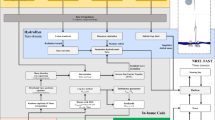Abstract
With an extreme load condition, the mooring system of a floating offshore wind turbine (FOWT) will be led to failure, such as mooring line breakage. However, the induced FOWT mooring line breakage in extreme gust still requires further study for design optimization in the future. In this paper, an aero-hydro-cable-servo time domain coupled simulation have been carried out of a NREL’s 5 MW OC4-DeepCwind semi-submersible type FOWT for investigate the mooring system response under extreme coherent gust with direction change (ECD) condition. The platform is assumed to be installed at 50 m depth location in the South China Sea. The practical ECD is simulated by a fast conversion between two wind conditions with different mean wind speeds and wind direction. In addition, the gust characteristics that can generate snap tension of mooring lines were identified, and the consequence of the induced ECD accident is investigated. ECD condition with rise time of 10 s is prone to cause a snap tension of the mooring line, and it may eventually lead to cascading mooring line breakage and potential catastrophic collision events.
















Similar content being viewed by others
References
Ruzzo C, Fiamma V, Collu M, Failla G, Nava V, Arena F (2018) On intermediate-scale open-sea experiments on floating offshore structures: feasibility and application on a spar support for offshore wind turbines. Mar Struct 61:220–237
Haghroosta T, Wan RI (2017) Typhoon activity and some important parameters in the South China Sea. Weather Clim Extremes 17:29–35
Rodrigues S, Restrepo C, Kontos E, Pinto RT, Bauer P (2015) Trends of offshore wind projects. Renew Sust Energ Rev 49:1114–1135
Zhang X, Sun L, Sun H, Guo Q, Bai X (2016) Floating offshore wind turbine reliability analysis based on system grading and dynamic FTA. J Wind Eng Ind Aerodyn 154:21–33
Ahmed MO, Yenduri A, Kurian VJ (2016) Evaluation of the dynamic responses of truss spar platforms for various mooring configurations with damaged lines. Ocean Eng 123:411–421
Hallowell ST, Arwade SR, Fontana CM, Degroot DJ, Aubeny CP, Diaz BD (2018) System reliability of floating offshore wind farms with multiline anchors. Ocean Eng 160:94–104
Det Norske Veritas (DNV) (2014), DNV-OS-J101, design of offshore wind turbine structures
Larsen GC, Hansen KS (2008) Rational calibration of four IEC 61400-1 extreme external conditions. Wind Energy 11(6):685–702
Bae YH, Kim MH, Kim HC (2017) Performance changes of a floating offshore wind turbine with broken mooring line. Renew Energy 101:364–375
Li Y, Zhu Q, Liu L, Tang Y (2018) Transient response of a spar-type floating offshore wind turbine with fractured mooring lines. Renew Energy 122:576–588
Duan F, Hu Z, Niedzwecki JM (2016) Model test investigation of a spar floating wind turbine. Mar Struct 49:76–96
Kai-hui J (2005) Study on buoy mooring system. PhD thesis, Tianjin University, Tianjin, China
Zhang SX, Tang YG, Zhang RY, Lin WX, Yang G (2009) Experimental investigation into factors affecting marine cable snap tension in taut-slack conditions. J Harbin Eng Univ 30(10):1102–1107
Hsu WT, Thiagarajan KP, Manuel L (2017) Extreme mooring tensions due to snap loads on a floating offshore wind turbine system. Mar Struct 55:182–199
Hsu WT, Thiagarajan KP, MacNicoll L, Akers R (2015) Prediction of extreme tensions in mooring lines of a floating offshore wind turbine in a 100-year storm. In: Proceedings of the ASME 2015 34th International Conference on ocean, offshore and arctic engineering, May 31–June 5, 2015, St. John’s, Newfoundland, Canada
Ebrahimi A, Sekandari M (2018) Transient response of the flexible blade of horizontal-axis wind turbines in wind gusts and rapid yaw change. Energy 145:261–275
Menegozzo L, Monte AD, Benini E, Benato A (2017) Small wind turbines: a numerical study for aerodynamic performance assessment under gust conditions. Renew Energy 121:S0960148117312892
Storey R, Norris S, Cater J (2014) Modelling turbine loads during an extreme coherent gust using large eddy simulation
Det Norske Veritas (DNV) (2011) SESAM user manual
Hansen MOL (2008) Aerodynamics of wind turbines, James & James Ltd
Larsen K, Sandvik PC (1990) Efficient methods for the calculation of dynamic mooring line tension
SIMO 4.10.3 Theory Manual (2017), SINTEF Ocean
American Petroleum Institute (2005) API-RP-2SK, design and analysis of stationkeeping systems for floating structures
Det Norske Veritas (DNV) (2013) DNV-OS-E301, position mooring
Jonkman, Butterfield, Musial, & Scott. (2009) Definition of a 5-MW reference wind turbine for offshore system development. Office of Scientific and Technical Information Technical Reports
Coulling AJ, Goupee AJ, Robertson AN (2013) Validation of a FAST semi-submersible floating wind turbine numerical model with deepcwind test data. J Renew Sustain Energy 5(2):023116
Det Norske Veritas (DNV) (2014) DNV-RP-205, environmental conditions and environmental loads
Safetec (2013) Causal Relationships and Measures Associated with Structural and Maritime Incidents on the Norwegian Continental Shelf. Tech. Rep. Petroleum Safety Authority, Norway
Ni W, Zhang X, Xu F et al. (2019) Numerical investigation of bifurcation characteristics under perturbations in vortex induced vibration of cylinder with two degrees of freedom. Ocean Eng, 188
Zhang X, Sun L, Ma C et al (2016) A reliability evaluation method based on the weakest failure modes for side-by-side offloading mooring system of FPSO. J Loss Prevent Proc 41:129–143
Acknowledgements
This research is supported by the National Natural Science Foundation of China (Grant Nos. 51979050, 51739001, 51579056), the Natural Science Foundation of Heilongjiang Province of China (Grant No. E2017029), and the National Science and Technology Major Project of China (Grant No. 2016ZX05057020).
Author information
Authors and Affiliations
Corresponding author
Additional information
Publisher's Note
Springer Nature remains neutral with regard to jurisdictional claims in published maps and institutional affiliations.
About this article
Cite this article
Ma, G., Zhong, L., Zhang, X. et al. Mechanism of mooring line breakage of floating offshore wind turbine under extreme coherent gust with direction change condition. J Mar Sci Technol 25, 1283–1295 (2020). https://doi.org/10.1007/s00773-020-00714-9
Received:
Accepted:
Published:
Issue Date:
DOI: https://doi.org/10.1007/s00773-020-00714-9




